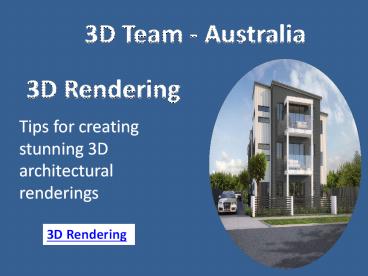3d rendering australia - PowerPoint PPT Presentation
Title:
3d rendering australia
Description:
3D Rendering, a mastering art to express any concept in a 3D image-based model where one can bring things into a life that may be a product, property, interior, and what else one needs – PowerPoint PPT presentation
Number of Views:7
Title: 3d rendering australia
1
3D Team - Australia
3D Rendering
Tips for creating stunning 3D architectural
renderings
3D Rendering
2
Architectural 3D renderings have become an
increasingly popular tool for architects to show
clients what a finished project would look like,
in a more realistic way than using scale models
or artists' drawings. But for an architectural
rendering to be successful, it must be as
photorealistic as possible. Here are some tips to
help you achieve a greater level of realism in
your renderings.
3D Architectural rendering
3
1. Chamfer your edges. Even on man-made objects,
there are no perfectly sharp edges. Beveling your
edges with a chamfer tool in your rendering
software not only makes your rendering more
realistic, it also brings out more detail by
allowing the edges to capture reflections from
your light source.
3D Interior designs
4
2. Do not use 100 black or white colors. To show
that an object has volume, it should have areas
highlighted and shaded using midtones for
contrast. If you have an all-black virtual
material, your model will look flat because the
differences between the shaded areas and the
midtones will not be visible. The same goes for a
completely white model, except that in this case,
it is the differences between the midtones and
highlights that are not visible.
3D Product rendering
5
3. Use a blurred background or depth-of-field
effects in your 3D architectural renderings, as a
certain amount of blurring is associated with
real-life photographs to indicate movement. Depth
effects can be applied during actual rendering,
or they can be added in post-production using the
lens blur and z depth pitch functions.
3D Industrial rendering
6
4. Use secular maps. These maps add more realism
to your renderings by telling the renderer which
parts should have high brightness (specularity)
and which parts should be more diffuse. But you
can also use specular maps to render objects that
are supposed to have a smooth finish, such as
ceramic, highlighting natural irregularities such
as bumps and scratches.
3D Medical rendering
7
5. Use shadows. When making exterior renderings,
you need to know what time it is supposed to be
so that you can reflect it in the cast shadows.
For example, if it is supposed to be morning, the
shadows should be soft and not very sharp. On the
other hand, at noon, the shadows are clear. The
type of lighting you use in your rendering is
something you should also consider for example,
sunlight creates softer shadows than artificial
lighting, which can cast sharper shadows.
3D Animation
8
6. Add dirt and clutter to the image. In real
life, even things that are supposed to be new are
not pristine and will have imperfections. So, add
these details to your renderings, like little
cracks. Or when making a room, avoid making it
too neat by adding some messy details, like a few
scattered objects. 7. Include skewness. In
nature, things are never completely symmetrical.
So once you're done with your 3D architectural
renderings, add asymmetric variation to make them
look more realistic.
3D Rendering
9
Team Designs Pty Ltd 5/27 Jacaranda Drive Carrum
Downs VIC 3201 Melbourne, Australia. Phone 61
03 8372 0157 Email sales_at_3dteam.com.au
https//www.3dteam.com.au/
10
THANK YOU































